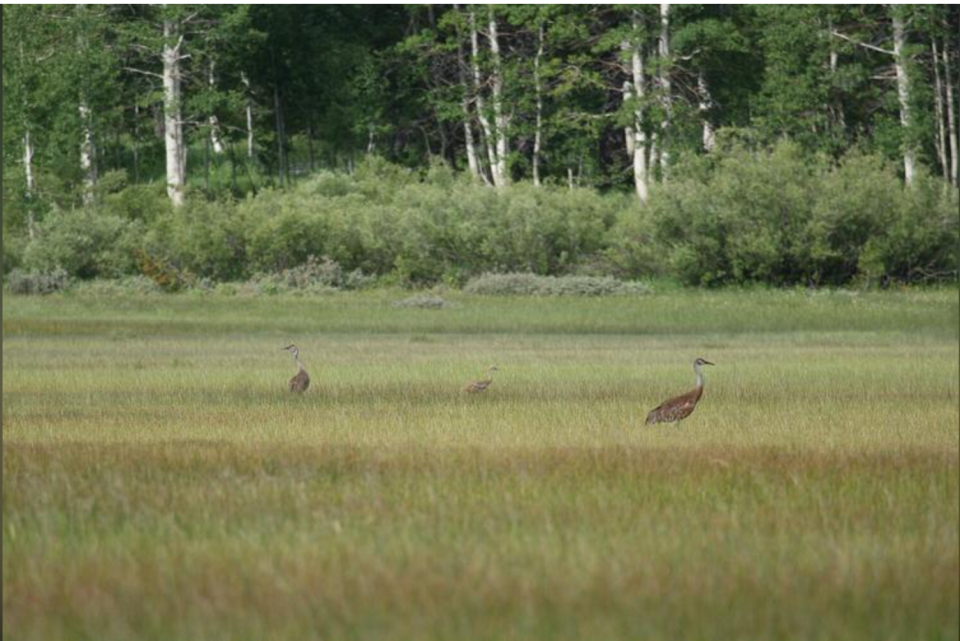Truth matters. Community matters. Your support makes both possible. LAist is one of the few places where news remains independent and free from political and corporate influence. Stand up for truth and for LAist. Make your tax-deductible donation now.
After 100 Years, Lake Tahoe is seeing an old friend: The sandhill crane

Spring is a time of rebirth and renewal. And this season, Tahoe is witnessing its own rebirth in the form of a species of bird that had been previously driven out of the region.
Sandhill cranes are making an unexpected return to the Lake Tahoe basin after a century long hiatus caused by overhunting. The birds stand at about 4 feet tall with a wingspan of 7 feet and boast a signature red patch on their head. The sandhill cranes are often compared to dinosaurs by those lucky enough to witness them due to their large size and loud croaks.
“They actually kind of paint their feathers, which is really rare in the bird world,” said Denys Hemen of the Audubon Center at Debs Park in Los Angeles. “So they'll take the mud and the sand that they get and they'll actually, like, color their feathers with it.”
These majestic birds' newfound presence in Tahoe signifies the latest turn in the species conservation journey, and serves as a testament of its strength and durability.

The effects of overhunting
Tahoe’s montane meadows and wetlands are ideal terrain for sandhill breeding nests, especially with California's record amount of rain over the last few winters potentially increasing the region’s wetlands. But, according to Will Richardson, executive director of the Tahoe Institute of Natural Sciences(TINS), a research, education, and outreach organization, the bird’s main reason for returning to Lake Tahoe is that they are no longer being hunted.
Sandhill cranes were a popular game in the early 1900s and almost completely hunted out of most of California by 1944, with only four to five nesting pairs recorded in the northernmost part of the state, Richardson said.
“There are no records of them breeding in Tahoe, historically, and I think that was probably because they just got hunted out before anybody showed up to take records,” he added.
Other western state populations suffered as well. Sandhill cranes were almost completely rooted out of Washington, and though numbers have been increasing, they remain an endangered species of the state. The Washington Department of Fish and Wildlife designated sandhill cranes a “species of greatest conservation need” with only about 40 breeding pairs recorded.
Sandhill cranes were still seen wintering in California, mainly in the Central and San Joaquin valleys, but they didn’t return to nesting and breeding in the Sierra Valley for the spring until the 1950s, Richardson said.
And over the last several years, sandhill cranes have been slowly moving more south. In 2015, a few nests were documented near the Truckee River, and in 2018, the first sandhill nest was recorded in Tahoe.
“Their population is rebounding and as a consequence, they're expanding to reclaim old range from centuries ago,” Richardson said. “They're no longer under severe hunting pressures.”

But that doesn’t mean they aren’t still at risk.
Persisting risks threaten recovering population
Sandhill cranes have a long and vulnerable breeding season, according to Richardson. Their eggs incubate for about 30 days, and young sandhills don't learn how to fly until several months after birth.
Although springtime in Tahoe is not peak tourism season, the amount of time sandhills spend in the area to nest and breed makes them more susceptible to interference from potential hikers and visitors.
“If you are canoeing or paddleboarding in a marsh or wetland, and all of a sudden you hear a crane or see a crane stand up, turn around. Back up,” Richardson said. “You don't want to get too close. You don't want to flush them off a nest.”
If spooked, Richardson said these big birds can accidentally roll their eggs or even their young into the surrounding water. Richardson said he believes this is what happened to a sandhill nest in the upper Truckee Marsh last summer that didn’t survive.

A story of survival and resilience
Outside of the Lake Tahoe basin, sandhill cranes face habitat loss as the marsh and wetlands they like to roost in have been cleared for farmland.
“Development in wetlands, water being taken from these shallow rivers. All of these things together can cause a great decline in these birds if we're not careful,” said Hemen from the Audubon Center at Debs Park.
Some farmers and ranchers have teamed up with Audubon California’s Working Lands Program and other land managers to reflood these farms during certain points in the year to recreate the marshy wetlands the cranes like to nest in.
“Historically, the main threats to habitat was conversion to farmland or pasture,” Richardson said. “Folks were really aggressive draining wetlands back in the day, and now land managers are very busily trying to right those wrongs and restore old stream flows and make functioning wetlands again.”
But in the Tahoe basin, Richardson said the damage has already been done.
Which is why the story of the sandhill crane coming back to Tahoe is so amazing. Because they have come back just by their own resilience.
For any tourists looking to witness these resilient birds for themselves, Richardson recommended skipping Tahoe and taking a drive a little further north to the Sierra Valley, where the population is more stable and less vulnerable to human disturbance.
“A good first step for us is to just try to let the public know that they can help by not harming,” he said. “If given enough space and left to their own devices, they should be all right.”








